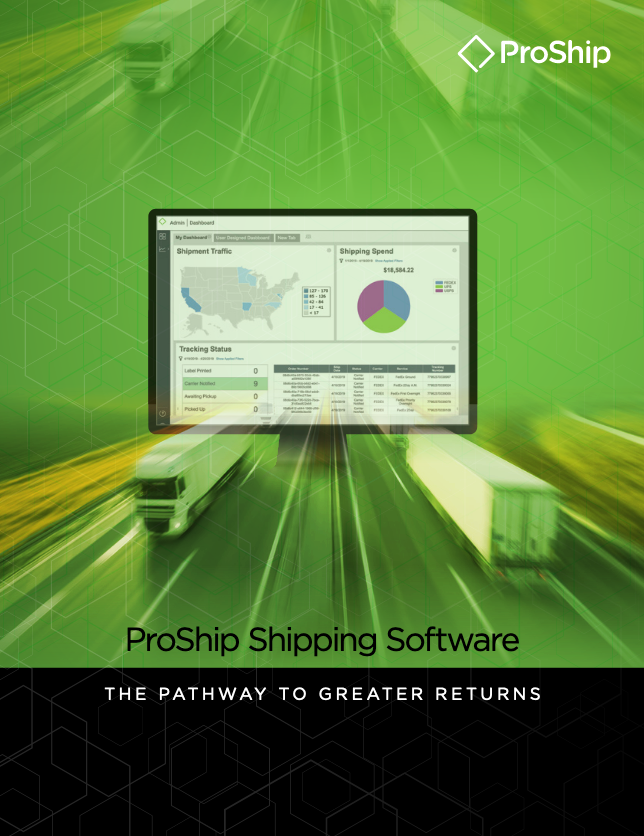Top 4 Direct-to-Consumer Parcel Shipping Challenges for Manufacturers

Due to e-commerce growth, many manufacturers see opportunity in a DTC shipping model.
It’s no surprise that e-commerce is becoming the preferred method of shopping for today’s consumers. E-commerce grew over 14.9% in 2019 alone (and accounted for more than half—56.9%—of all gains in the retail market that year), and it’s not something that has just begun – in fact, the average growth rate of e-commerce was over 20% each year from 2014-2018.
With that growth, there has been a shift in the way consumer product brands ship products. The traditional model of exclusively fulfilling bulk orders, picking full cases, building pallets and shipping truckloads of products to big box distribution centers is no more – shipping opportunities have now expanded. There is now the opportunity to fulfill thousands of small, individual orders that are shipped directly to the consumer. A manufacturer can be a drop ship vendor, where you’re essentially fulfilling orders within your warehouse to the end-consumer on behalf of an e-commerce retailer, or a manufacturer can become its own e-commerce powerhouse by implementing an e-commerce website.

Deciding to ship direct-to-consumer (DTC) is a huge decision, because instead of picking 50 identical bulk distribution center-type orders, you’re now picking 50 unique orders, each with their own quantities and requirements, and you’re going to have to think about, for instance… What label has to go on each? What type of service are we using? What does the pack slip and box need to look like? To guide you through this, let’s take a look at the top challenges.
Here are the top 4 Direct-to-Consumer Parcel Shipping Challenges for Manufacturers
Challenge #1: Managing Increased Order Volume
When moving towards a DTC model, you will see a significant increase in shipping volume because as stated previously, now you’re processing thousands of single orders to consumers on a daily basis. The most important thing is being able to manage this increase in an efficient way. It’s also important to note that you will now be using more small parcel carriers rather than LTL carriers.
TIP: Good WMS and shipping software can help move the complexity of this increased volume out of the warehouse personnel’s hands, allowing them to focus solely on managing increased parcel volume.
Challenge #2: Adhering to Retailer Requirements
If you’re going to drop ship for e-commerce retail partners, you will need to adhere to their specific requirements when shipping their products. These requirements can span far and wide. For instance, you may need to provide inventory availability information so retailers can include the number of items left (2 items in-stock, better buy it soon!) in real-time on their website. They also may require order confirmations that include order statuses, and you’ll need to make sure you have compliant labels and branded packing slips (and the list goes on). If you don’t meet these requirements, you risk fines that can quickly add up.
Challenge #3: Maintaining Consistent and Efficient Warehouse Processes
Since you have increased the number of DTC orders to fulfill, you want to make sure you aren’t picking, packing and labeling each of these orders individually. Keep in mind that depending on the retailer or your own company’s requirements, there may be added complexities you will need to address, such as special packaging requirements that can really hinder warehouse productivity.
TIP: It’s important to be integrated with systems that can create efficiencies in these processes without adding hours of manual work or worse, increasing headcount. The last thing you want to do is add hard-to-find warehouse employees to handle increased parcel volume.
Challenge #4: Controlling Shipping Methods and Costs
Whether you’re fulfilling for retailers or for your own website (or both!), small parcel volume will increase, and you’ll go from shipping a handful of parcels via UPS to filling UPS trailers each day. You don’t only have to be efficient in terms of generating small parcel shipments (i.e. getting the labels and applying them) but you also must be concerned about selecting the carrier and appropriate level of service. It all comes down to shipping costs and transit times. For instance, if you have a commitment to get a package to a consumer in 2 days, but you don’t want to break the bank in doing so, you will want to rate shop your carriers and their services to find which will meet both your commitment time and cost you the least.
To overcome these challenges, you will want to take a long look at your current enterprise technology stack and understand where your small parcel operation may faulter. This will give you some insight into which enterprise technologies may be currently insufficient (lacking functionality) or even missing from your current warehouse environment.
Here are a couple of technologies to take a hard look at
Warehouse Management Systems (WMS)
A WMS software application supports day-to-day warehouse operations. It enables the centralization of tasks such as tracking inventory levels and stock locations, as well as maximizing the use of facilities. It also estimates the expected labor productivity rates by function or activity. With the technology team’s help in installing this system and ensuring its reliability, supply chain professionals can plan for processing orders, including picking and staffing.
Enterprise Resource Planning (ERP)
These systems manage the main business processes in real-time. This is especially important for the supply chain department as ERPs track cash, raw materials and production capacity, as well as the status of orders and purchase orders.
Electronic Data Interchange (EDI)
For manufacturers of any size, implementing EDI is essential as it reduces costs and improves operational performance across your business. EDI was originally used to place orders electronically, acknowledge, then confirm the order is being sent once the manufacturer put it on a pallet. Regarding the challenges of DTC, EDI software can expose available inventory and help communicate shipping updates.
Order Management System (OMS)
This software keeps track of every order shippers receive and ensures it is processed correctly. Typically used by retailers, an order management system tracks orders from inception to fulfillment and manages the people, processes and data connected to the order as it moves through its lifecycle. Having a strong OMS is important for manufacturers who have “showroom” stores and plan to use them for DTC fulfillment in the future (aka omnifulfillment).
Customer Relationship Management (CRM)
You’re now shipping DTC, which means you need to be 100% concerned with the customer experience as it relates to ordering and delivery. Understanding customers’ expectations on delivery is vital. Using CRM software, supply chain professionals can review data on customers’ history to improve customer satisfaction. This can showcase the business’ unique customer preferences so you can better meet their demands when it comes to delivery.
Multi-Carrier Shipping Software
While these systems all work well separately, there is one core software that can seamlessly integrate into all of them to greatly improve the customer experience and decrease shipping costs – shipping software. Remember that challenge about controlling shipping methods and costs? Here’s your remedy! When shipping DTC, it’s extremely important to find the right shipping tool that can identify the closest inventory source to the customer and find the best shipping method amongst hundreds of carriers and services. The tool must also offer complete compliancy by printing accurate carrier-compliant shipping labels in seconds in order to meet the customer’s desired delivery date.
TIP: Ensure all of the software vendors in your enterprise software stack have ownership of their IP to ensure they can best assist you with customizations, troubleshooting and speed increases.
When implementing DTC shipping, you’ll come to realize that sometimes you will only have hours to get these orders out the door, so every minute counts and you need to be 100% accurate or be hit with fines and penalties (or even delayed orders). On the bright side, remember that you don’t have to do it alone. Each of the technologies explained above have shipping experts that can help you devise a plan that works for your unique environment.

Want to meet our shipping expert?
Dave Salter is the expert manufacturing teams go to when they want to improve their DTC shipping strategy or are just starting and want to learn how they can become successful. He can talk you through your challenges, give advice and even provide some customized solutions that will integrate directly into your current enterprise technology stack.
ProShip content you may also like…